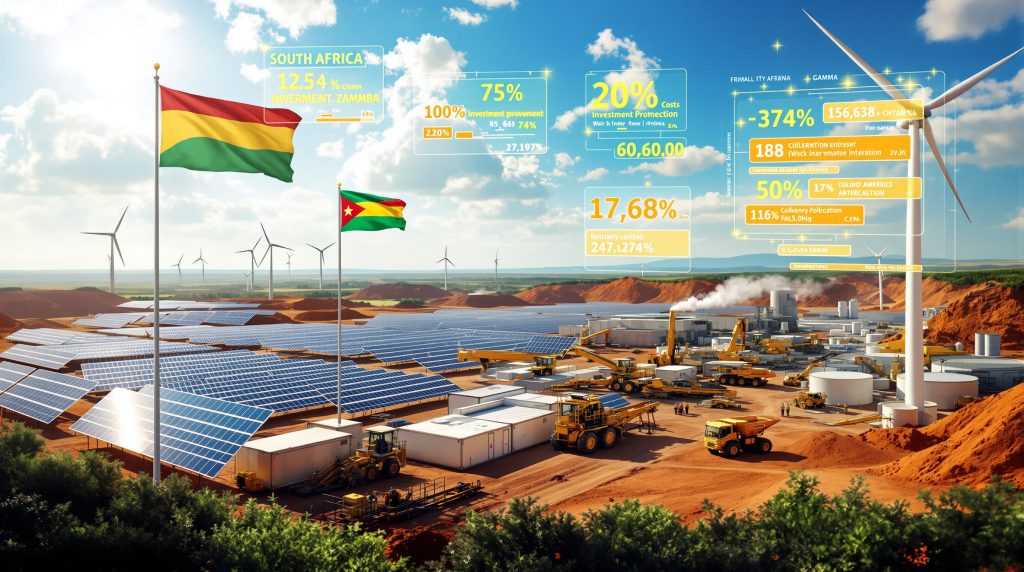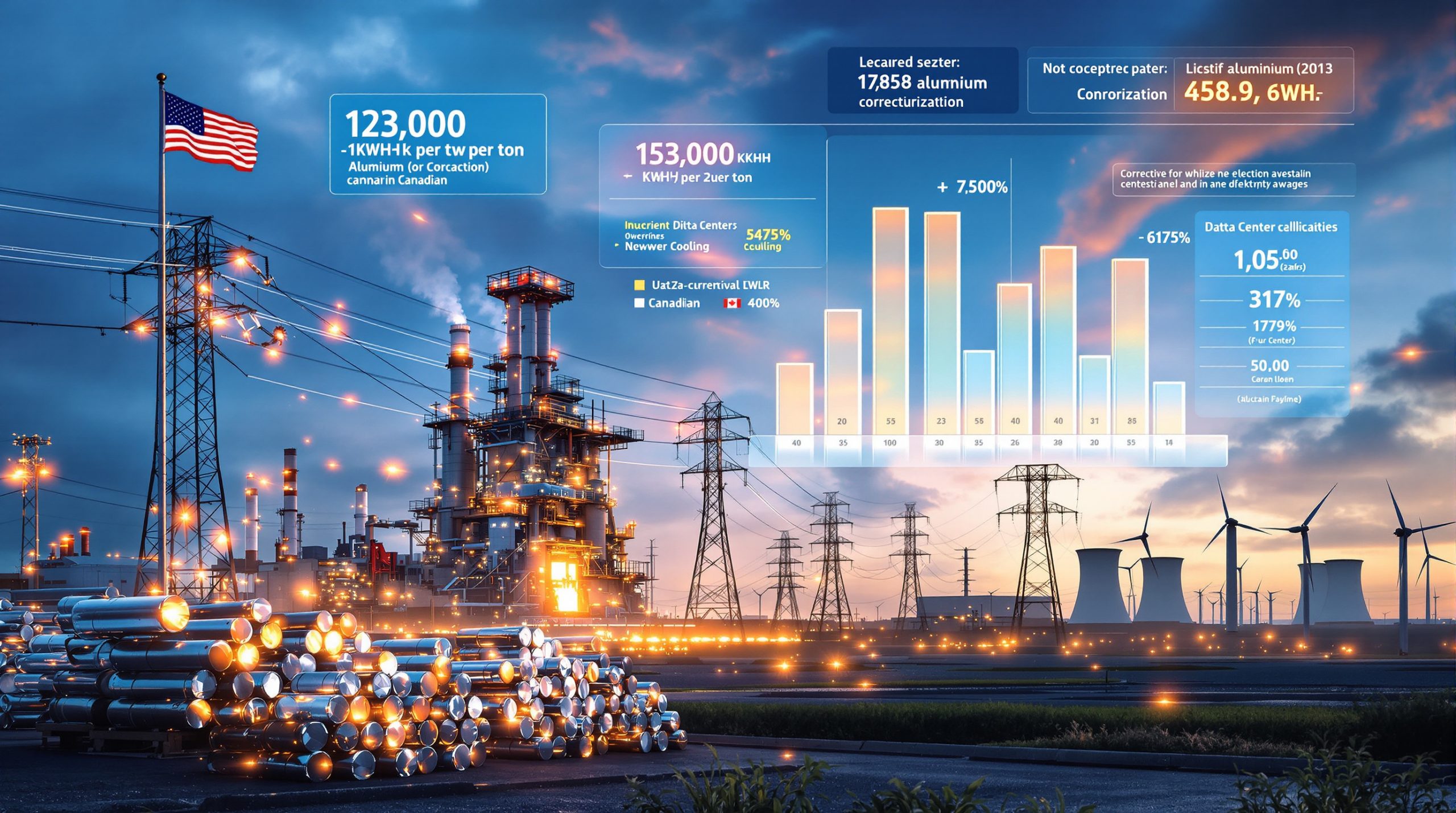Energy Challenges Driving Africa's Mining Transformation
African mining operations are experiencing a fundamental shift in their energy strategies, driven by escalating operational costs and mounting environmental pressures. Recent developments demonstrate how renewable energy solutions for Africa's mining industry are emerging as both economic necessities and strategic advantages for operators across the continent.
The transformation gained significant momentum with Voltalia's partnership with the International Finance Corporation, announced in mid-October 2025, targeting renewable energy deployment across Ghana, Guinea, Zambia, and Madagascar. This collaboration represents a strategic pivot toward industrial decarbonization markets for Voltalia, which currently operates over 2.7 gigawatts of installed renewable capacity globally.
Current Energy Dependencies Create Operational Vulnerabilities
Mining companies across Africa face substantial energy-related challenges that significantly impact their operational viability. Diesel dependency remains particularly problematic for off-grid operations, creating vulnerability to fuel price fluctuations and supply chain disruptions. Many operations experience frequent power outages when connected to national grids, forcing reliance on expensive backup generation systems.
The financial burden extends beyond direct fuel costs. Transportation logistics for diesel fuel to remote mining locations add substantial expenses, while maintenance requirements for traditional generator systems create ongoing operational complexity. These challenges become more acute as commodity prices fluctuate, putting additional pressure on profit margins.
Environmental and Investment Pressures Accelerate Change
The mining sector faces increasing scrutiny from multiple stakeholders demanding cleaner operational practices. ESG investment criteria now heavily influence funding decisions, with many institutional investors requiring demonstrable carbon footprint reductions before committing capital to mining projects.
International buyers, particularly in Europe and North America, increasingly demand sustainable supply chains from their mineral suppliers. This creates competitive advantages for operations that can demonstrate lower carbon intensity in their production processes. Local communities also advocate for cleaner operations, recognising the health and environmental benefits of reduced diesel generator emissions.
Furthermore, government policy support across the continent increasingly promotes renewable energy adoption, with several countries implementing supportive regulatory frameworks for private renewable energy development in industrial applications.
Renewable Energy Technologies Suited for Mining Applications
The mining industry requires consistent, high-capacity power solutions capable of handling extreme operational demands. Several renewable technologies have demonstrated effectiveness specifically for African mining applications, with hybrid systems showing particular promise.
Solar-Plus-Storage Systems Lead Adoption
Solar photovoltaic systems integrated with battery storage offer several advantages for mining operations. Modular deployment allows for phased expansion, matching energy capacity growth with mine development schedules. These systems provide predictable energy costs over 20-25 year operational lifespans, enabling accurate long-term financial planning.
The minimal water requirements of solar systems prove particularly valuable in arid regions where many mining operations are located. Installation timelines are significantly shorter compared to traditional power infrastructure development, allowing faster deployment to support production schedules.
From the FurtherAfrica report, project investments range between US$20 million and US$150 million, depending on mine capacity and load requirements. This scalability makes solar-plus-storage viable for operations of varying sizes across the continent.
Wind-Solar Hybrid Configurations Enhance Reliability
Combining wind and solar generation creates complementary energy profiles that enhance overall system reliability. Daytime solar peak generation typically aligns with processing operations that require maximum power during daylight hours. Evening wind generation often increases when solar output declines, supporting continuous mining activities.
Seasonal balancing represents another significant advantage, as wind resources are typically stronger during months when solar irradiation is reduced. This natural complementarity reduces the required battery storage capacity, lowering overall system costs while maintaining operational reliability.
Hydroelectric Integration for Water-Rich Regions
Mining operations located near suitable water resources can benefit from small-scale hydroelectric systems. These installations offer baseload power generation with minimal operational costs after initial construction. Hydroelectric systems can operate for 50-100 years with proper maintenance, providing exceptional long-term value.
The environmental benefits include virtually zero operational emissions and minimal ongoing fuel or maintenance requirements compared to diesel alternatives. However, regulatory approval processes for hydroelectric projects typically require longer development timelines than solar or wind installations.
African Countries Leading Mining Renewable Energy Development
Continental adoption of renewable energy solutions for Africa's mining industry varies significantly based on regulatory frameworks, resource availability, and mining sector maturity. Several countries have emerged as leaders in implementing innovative financing and policy approaches.
South Africa's Regulatory Framework Drives Innovation
South Africa has established comprehensive regulatory frameworks supporting private renewable energy development. The Renewable Energy Independent Power Producer Procurement Programme (REIPPPP) has created successful precedents for renewable energy project financing and development.
Carbon tax implementation creates additional cost pressures on traditional fossil fuel generation, improving the economic case for renewable alternatives. Wheeling regulations allow private entities to trade renewable energy, enabling mining companies to develop shared renewable infrastructure or sell excess capacity.
These regulatory advances have attracted significant mining industry investment in renewable energy projects, with platinum, gold, and chrome producers implementing various solar and wind installations across their operations.
Ghana Emerges as Gold Mining Innovation Hub
Ghana's unreliable national grid has driven private renewable energy adoption among mining companies. International mining operations have taken leadership roles in technology deployment, often serving as demonstration projects for broader industry adoption.
Government incentives for renewable energy investments, combined with the country's excellent solar resource, create favourable conditions for mining renewable energy projects. Surface mining operations have particular advantages in implementing solar installations due to available land areas and straightforward integration with existing electrical infrastructure.
According to the FurtherAfrica report, feasibility studies are currently underway in Ghana as part of the Voltalia-IFC partnership, indicating continued momentum in the country's mining renewable energy development.
Zambia Modernises the Copper Belt Through Energy Diversification
Zambia's government actively promotes energy diversification initiatives, recognising the economic benefits of reducing dependence on traditional energy sources. Mining companies have formed renewable energy consortiums to share development costs and technical expertise.
Cross-border power sharing agreements with neighbouring countries provide additional flexibility for renewable energy development, allowing larger-scale projects that can serve multiple markets. The country's copper mining operations require substantial energy inputs, making them ideal candidates for large-scale renewable energy installations.
Investment commitments continue growing, with feasibility studies underway as part of the Voltalia-IFC collaboration, demonstrating international confidence in Zambia's renewable energy potential for mining applications.
Power-to-Mine Solutions Address Complex Operational Requirements
Power-to-Mine (PtM) models represent integrated approaches combining renewable generation, energy storage, and smart grid management specifically designed for mining operations. These systems address the unique challenges of providing reliable power to energy-intensive industrial processes.
Modular Architecture Enables Flexible Implementation
PtM systems incorporate multiple complementary technologies within unified control frameworks. Generation modules can include solar panels, wind turbines, or hybrid combinations optimised for specific site conditions. Battery storage systems provide load balancing and backup power during periods of low renewable generation.
Advanced control systems use artificial intelligence to optimise energy management, predicting demand patterns and adjusting generation and storage accordingly. Reduced backup diesel capacity serves emergency situations while minimising ongoing fuel dependency and operational complexity.
The Voltalia-IFC partnership utilises this PtM approach, described as a flexible, modular system integrating renewable generation with energy storage, designed for both off-grid and grid-connected mining operations.
Operational Benefits Deliver Competitive Advantages
PtM systems significantly improve operational reliability compared to traditional diesel-dependent power systems. Redundant generation and storage components ensure consistent power delivery during peak demand periods. Reduced dependency on external grid infrastructure provides operational independence and cost predictability.
The systems provide consistent power while reducing carbon footprints and operational costs, validating that decarbonisation can align with profitability objectives. Elimination of fuel transportation logistics reduces both costs and operational complexity, particularly for remote mining locations.
Scalability Supports Mine Development Cycles
PtM systems accommodate mine expansion without requiring proportional energy infrastructure investment. Modular design allows capacity additions as production increases, spreading capital expenditure across development phases. Seasonal production variations can be managed through flexible capacity allocation.
Technology upgrades can be implemented without complete system replacement, allowing mining operations to benefit from advancing renewable energy technologies throughout their operational lifespans. This adaptability provides long-term value protection for capital investments.
Financial Models Enabling Energy Transition
In addition to developing robust technical solutions, financing renewable energy solutions for Africa's mining industry requires innovative approaches addressing the unique risks and capital requirements of both sectors. Successful projects utilise blended finance structures combining development finance with private sector investment.
Development Finance Institution Leadership
The IFC's role in the Voltalia partnership demonstrates how development finance institutions provide project finance, risk-mitigation tools, and advisory support. This approach represents blended finance where development institutions act as catalysts rather than solely as lenders.
Risk mitigation through partial guarantees reduces private sector investment risks, enabling commercial participation in projects that might otherwise be considered too risky. Concessional financing reduces overall project costs, improving investment returns for private participants.
Technical assistance for project development helps ensure proper implementation and operational success. This comprehensive support addresses multiple barriers that traditionally limit private investment in African renewable energy projects.
Private Sector Engagement Models
Power Purchase Agreements with long-term commitments provide revenue certainty that supports project financing. Build-Own-Operate-Transfer models allow mining companies to access renewable energy without large upfront capital commitments.
Energy-as-a-Service contracts eliminate upfront capital requirements entirely, allowing mining companies to focus resources on core mining operations while accessing clean energy solutions. These models have proven particularly attractive for smaller mining operations with limited access to development capital.
Investment Returns and Financial Performance
The partnership validates the business case for renewables in energy-intensive sectors, proving that environmental benefits can align with profitable investment returns. Project investment sizes between US$20 million and US$150 million demonstrate scalability across different operation sizes.
Successful projects typically achieve positive returns within reasonable payback periods, making them attractive to both development finance institutions and private investors. Debt service coverage ratios for well-structured projects provide adequate security for lenders while delivering competitive returns for equity investors.
Challenges Limiting Widespread Adoption
Despite promising developments, several barriers continue limiting renewable energy deployment in African mining operations. Addressing these challenges requires coordinated efforts among mining companies, financial institutions, technology providers, and governments.
Regulatory and Policy Complications
Many African mining jurisdictions are still reforming electricity laws to allow independent renewable producers to supply private industrial clients. Grid connection processes often involve complex regulatory approval procedures that create project delays.
Utility resistance to private renewable energy projects stems from concerns about lost revenue and grid management complexity. Inconsistent policy frameworks across countries create uncertainty for investors developing multi-country renewable energy strategies.
Permitting complexities include environmental impact assessment requirements, land use rights for renewable installations, and cross-border energy trading restrictions for regional projects. These regulatory barriers often extend development timelines and increase project costs.
Technical and Infrastructure Constraints
Transmission line capacity limitations restrict the ability to transport renewable energy from optimal generation sites to mining operations. Grid stability issues in remote locations create technical challenges for integrating large-scale renewable installations.
Limited local technical expertise for system maintenance creates long-term operational risks. Many African countries lack sufficient numbers of trained technicians capable of servicing advanced renewable energy and storage systems.
System reliability requirements during extreme weather events demand robust backup systems and weather-resistant equipment. These technical requirements often increase capital costs and system complexity.
Financial and Market Risk Factors
High upfront capital requirements create financing challenges, particularly for smaller mining operations with limited access to international capital markets. Currency risks for international financing create additional complexity for project financial structuring.
Limited local banking capacity for large-scale renewable projects means most financing must come from international sources, creating foreign exchange and regulatory complications. Commodity price volatility affects mining company cash flows, creating uncertainty about their ability to meet long-term power purchase commitments.
Market observers note that achieving scalability depends on regulatory clarity and stable power purchase agreements. These factors significantly influence project viability and investor confidence.
Emerging Technologies Expanding Future Possibilities
Advanced energy storage solutions and smart grid technologies continue expanding possibilities for renewable energy in African mining operations. These innovations address current limitations while creating new opportunities for system optimisation.
Next-Generation Battery Technologies
Flow batteries offer extended operational lifespans with minimal performance degradation over thousands of charge-discharge cycles. These systems can provide longer-duration storage compared to traditional lithium-ion batteries, making them suitable for seasonal energy balancing.
Compressed air energy storage systems can provide large-scale, long-duration backup power for major mining operations. These systems use excess renewable generation to compress air in underground caverns, releasing it through turbines to generate electricity during peak demand periods.
Hydrogen production and storage systems enable seasonal energy storage and backup power generation. Electrolysis systems use excess renewable electricity to produce hydrogen, which can be stored long-term and converted back to electricity through fuel cells during periods of high demand.
Technology Performance Comparison
| Technology | Typical Duration | Round-Trip Efficiency | Primary Applications |
|---|---|---|---|
| Lithium-ion batteries | 2-6 hours | 85-95% | Daily load balancing |
| Flow batteries | 4-12 hours | 70-85% | Extended backup power |
| Compressed air storage | 6-24 hours | 60-70% | Large-scale storage |
| Hydrogen systems | Days to weeks | 35-45% | Seasonal storage |
Artificial Intelligence and Smart Grid Integration
Predictive analytics systems forecast energy demand based on mining operation schedules, weather patterns, and historical consumption data. These systems enable proactive energy management, optimising renewable generation and storage utilisation.
Automated load balancing distributes energy across multiple generation sources while minimising costs and maximising system efficiency. Real-time optimisation adjusts energy storage charging and discharging based on generation availability and demand requirements.
Enhanced predictive maintenance capabilities identify potential equipment issues before they cause system failures, reducing downtime and maintenance costs. These AI-powered systems significantly improve overall system reliability and operational efficiency.
Innovative Financing and Revenue Models
Green bond issuance provides dedicated financing for environmental projects, often at favourable interest rates compared to traditional corporate debt. Mining companies increasingly access green bond markets to finance renewable energy installations.
Carbon credit monetisation creates additional revenue streams from emission reductions achieved through renewable energy adoption. Mining operations can sell verified carbon credits in international markets, improving project economics.
Equipment leasing arrangements reduce upfront capital requirements while providing access to advanced renewable energy technologies. These models make renewable energy accessible to smaller mining operations with limited capital availability.
Community and Economic Development Benefits
Renewable energy adoption in mining creates broader socioeconomic benefits extending beyond individual operations. These positive impacts strengthen the business case for renewable energy while contributing to sustainable development goals.
Employment Creation and Skills Development
Construction phases of renewable energy projects create substantial temporary employment opportunities in engineering, construction, and logistics. Operations phases require permanent technical staff for system monitoring, maintenance, and administration.
Skills transfer programmes provide training opportunities for local workers in renewable energy technologies. Many mining companies partner with educational institutions to develop technical training programmes that create long-term employment opportunities beyond the mining sector.
Technology transfer to local engineering and construction firms builds domestic capabilities in renewable energy development and maintenance. These capabilities support broader economic development by creating service industries that can serve multiple sectors.
Community Energy Access Expansion
Excess renewable energy capacity can support community electrification programmes in rural areas surrounding mining operations. Shared infrastructure development reduces per-unit costs for community energy access while creating positive stakeholder relationships.
Microgrid development serves rural communities that lack access to national electrical grids. Mining renewable energy projects often create opportunities for extending electrical service to schools, healthcare facilities, and small businesses in surrounding areas.
Educational and healthcare facility power supply improves community services while demonstrating mining companies' commitment to local development. These investments create positive long-term relationships between mining operations and local communities.
Environmental and Health Impact Improvements
Reduced diesel generator emissions significantly improve air quality in mining areas and surrounding communities. Lower particulate matter concentrations reduce respiratory health risks for workers and local populations.
Water resource protection benefits include reduced fuel transportation and storage risks, minimising potential groundwater contamination. Renewable energy systems typically require less industrial water for cooling compared to traditional power generation methods.
Mining operations demonstrate environmental stewardship through renewable energy adoption, potentially influencing other industrial operations in their regions to pursue similar clean energy solutions.
Future Outlook for African Mining Energy Transformation
The trajectory for renewable energy solutions for Africa's mining industry points toward accelerated growth and increasing technological sophistication. Multiple factors converge to create favourable conditions for continued expansion.
Market Growth and Investment Trends
Africa supplies critical minerals essential for global clean energy transitions, including over 60% of the world's cobalt and 40% of manganese. This strategic position creates increasing pressure for sustainable extraction methods.
International demand for responsibly sourced minerals continues growing as global clean energy deployment accelerates. Mining operations that can demonstrate low-carbon production methods will likely capture premium pricing and preferential supply contracts.
Technology cost trends favour renewable energy adoption, with solar and battery technologies experiencing continued cost reductions. These trends improve the economic case for renewable energy in mining applications while making projects accessible to smaller operations.
Regulatory Evolution and Policy Support
Regional harmonisation of renewable energy regulations will simplify cross-border project development and energy trading. Simplified permitting processes specifically for mining renewable projects could reduce development timelines and costs.
Enhanced frameworks for cross-border energy trading will enable larger-scale renewable projects serving multiple countries, improving project economics through economies of scale. However, government initiatives increasingly include mining sector requirements in national renewable energy targets.
Tax incentives and public-private partnerships for clean energy mining investments create additional support for project development. These policy developments demonstrate growing government recognition of renewable energy's economic and environmental benefits.
Technology Integration and Innovation
Mining operations may increasingly serve as virtual power plants, contributing to regional grid stability while optimising their own energy costs. Blockchain-based energy trading platforms could enable sophisticated energy commerce between mining operations and other industrial users.
Autonomous systems integration will reduce operational complexity while improving system reliability and performance. These advances will make renewable energy systems more accessible to mining operations lacking extensive technical capabilities.
Integration with emerging technologies like hydrogen production could create additional revenue streams for mining operations with excess renewable generation capacity. Consequently, these innovations expand the value proposition beyond traditional energy cost savings.
Sustainable Energy Future for African Mining
The transformation of Africa's mining industry through renewable energy solutions represents a fundamental shift toward sustainable industrial development. The convergence of declining technology costs, innovative financing mechanisms, and supportive policy frameworks creates unprecedented opportunities for mining companies to reduce operational expenses while enhancing environmental performance.
The Voltalia-IFC partnership demonstrates how strategic collaborations between private companies and development finance institutions can overcome traditional barriers to renewable energy deployment. This model validates the business case for renewables in energy-intensive sectors, proving that sustainable mining transformation can align with profitability objectives.
Success in this transition requires continued coordination among mining companies, financial institutions, technology providers, and governments to address remaining challenges while capitalising on emerging opportunities. For instance, companies embracing electrification & decarbonisation early will establish competitive advantages extending far beyond energy cost savings.
As global demand for critical minerals continues growing, African mining operations have unique opportunities to demonstrate that resource extraction and environmental stewardship can advance together. Furthermore, effective energy transition strategies create a model for sustainable industrial development that could influence sectors throughout Africa and beyond.
The integration of renewable energy solutions into Africa's mining industry represents more than a technological upgrade—it embodies a strategic repositioning of the continent's extractive industries for long-term competitiveness and sustainability in an increasingly carbon-conscious global economy. Ultimately, incorporating sound investment strategy fundamentals into renewable energy development ensures both financial viability and environmental sustainability.
Looking for Mining Companies Leading Africa's Energy Transition?
Discovery Alert's proprietary Discovery IQ model delivers real-time notifications on significant ASX mineral discoveries, including companies pioneering renewable energy adoption in their operations. Stay ahead of the market by identifying actionable opportunities in mining companies embracing sustainable practices, ensuring you're positioned for both immediate trading advantages and long-term investment success. Begin your 30-day free trial today to discover how major discoveries can generate substantial returns.




